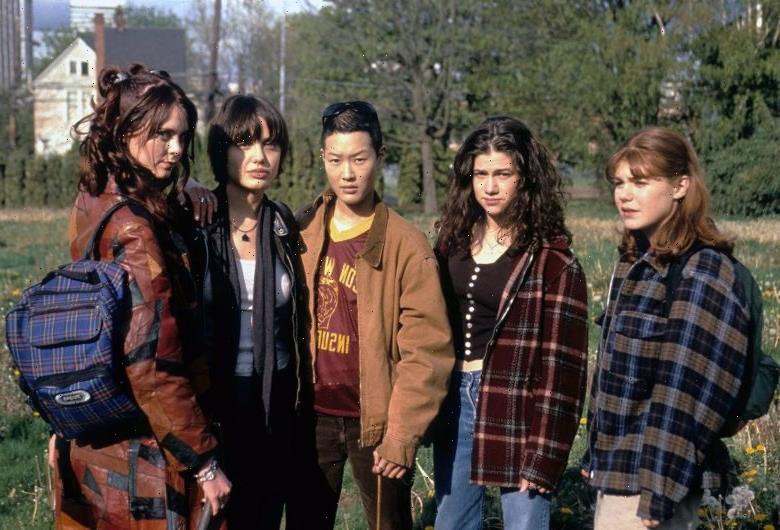Many an older film discovery will inspire revelations of “She’s in this?” — but none quite like the 1996 indie “Foxfire.” A cult classic beloved by queer audiences, “Foxfire” features early performances not only from Angelina Jolie, but singer-songwriter Jenny Lewis and queer icon and model Jenny Shimizu. It is also, famously (for those who care about these kinds of things), the project that introduced Jolie and Shimizu, who had a serious relationship throughout the late ’90s.
Based on a novel by Joyce Carol Oates, “Foxfire” follows five high school girls who take revenge on an abusive teacher, unwittingly forming a misfit crew of renegade feminists. They are radicalized by a hitchhiking firebrand who appears out of thin air, played by a young Jolie in motorcycle boots and an androgynous messy bob. Though she had done a few films prior, “Foxfire” established the magnetic bad girl type (and forever queer thirst trap) that would come to define Jolie’s early career, predating “Gia” (1998) and her big breakout, “Girl, Interrupted” (1999).
Casting is an unsung element of filmmaking that often gets ignored for flashier tricks, but great directors know its make-or-break power. By 1996, emerging director Annette Haywood-Carter already had an excellent track record: She had cast a baby Leonardo DiCaprio in her 1994 short “The Foot Shooting Party.” When it came time to cast “Foxfire,” she made another startling discovery. Jolie initially auditioned for a minor role, but Haywood-Carter instead set her as the mysterious lead after instantly recognizing her star power.
“I literally sat there thinking, ‘Oh my God, she’s a movie star.’ She was 19 years old. She was stunning. She was so complex,” the director said during a recent interview with IndieWire. “I asked her to come back and read for the lead … and she needed direction the first few takes. And the second audition, she wasn’t very good. She just needed me to give her some directions, and kind of a little bit pull the rug out from under her, because she had her thing that she did that just really didn’t work. It just wasn’t authentic.”
Still, she knew she had found something special. Once she settled on Jolie, Haywood-Carter had a tall task filling out the cast with actors who could stand up to her energy. “Angelina had so much personal power that I felt like she’s just going to eat these girls for lunch,” she said. “They wilted in her presence.”
She had a particularly hard time filling the role of Goldie, a queer loner who struggles with addiction.
Angelina Jolie in “Foxfire”
©Samuel Goldwyn Films/Courtesy Everett Collection
“Jenny Shimizu had never acted for the camera. She was a Calvin Klein model,” she said. “The casting director came in one day and showed me a picture of Jenny, and she was topless with a pair of Calvin Kleins on, leaning against the motorcycle. And she goes, ‘If she can act, do you want her?’ And I said, ‘Well, if she could act, yes, of course, I want her.’”
After a few coaching sessions with Shimizu, she brought Jolie in for a chemistry read. Needless to say, sparks flew.
“The chemistry between them was just brilliant from the get-go. And of course, we all know, they wound up kind of hooking up,” she said. “I saw what was going on between them, and I said to the producers, ‘Can we get Jenny some acting lessons?’ Because I still had not seen her act and I hadn’t seen it. But she was so responsive to Angelina. And of course, to me, half of acting is just being responsive to the other person.”
Though “Foxfire” got buried by MGM during its initial release, the film received renewed attention as Jolie’s star rose. (It probably didn’t help that the studio made her cut a queer kiss in the film — a move they later regretted.) Sadly, Haywood-Carter’s phone never rang. She received a few TV offers, but in those days, directors couldn’t shift so easily between mediums, and she wanted to direct movies. She had worked steadily as a script supervisor before “Foxfire,” but felt she couldn’t “go backwards.”
“The doors had opened to women, but they then closed again,” said Haywood-Carter, who also identifies as queer. “It was zero when I arrived in LA, and then in the mid-’90s, a handful of us got to direct Hollywood movies. It was three percent of the movies, and then it went up to nine percent over the next four or five years. And then it just plummeted again. It just went back down to three percent again.”
She made the best of it, building a robust career as an uncredited script doctor, a job she’s grateful to for honing her writing skills. In 2013, she directed her second feature, “Savannah,” attracting the likes of Jim Caviezel, Chiwetel Ejiofor, and Sam Shepard on the strength of a script she co-wrote with her husband Ken Carter. Ten years later, she’s releasing her third feature, the fluffy comedy “Daughter of the Bride,” starring Marcia Gay Harden as a woman whose daughter frets over her mother’s impending wedding.
She landed the for-hire studio gig thanks in part to a new DGA program called The Squad, which pairs mid-career directors with established director-mentors. The inaugural group, for which Haywood-Carter was chosen, focused on women whose careers would have been much further along by now had they been men.
“The mentor’s job was to just ask you what you needed and then do everything they could to get it,” she said. “I said, ‘I just need a movie. And to be perfectly honest, all you have to do is get me in a room. I can’t get myself in the room at this point, just get me in a room and I’ll get the movie.’”
Source: Read Full Article


